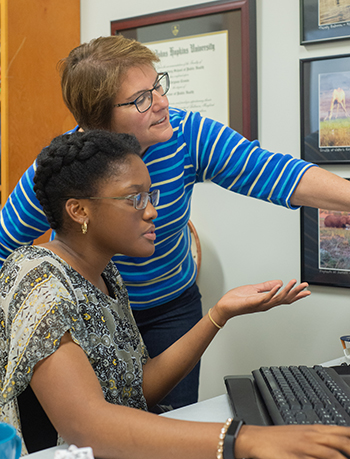Exposing Allentown’s Invisible Health Hazard
This summer, public health student Rashida Haye ’20 and her advisor presented the radon-communication research they collaborated on to state government officials.By: Meghan Kita Friday, August 10, 2018 04:24 PM
 Rashida Haye ’20 conducted spring and summer research on radon, a health hazard that's prevalent in the Lehigh Valley. Photos by Maddy Kirchofer ’20.
Rashida Haye ’20 conducted spring and summer research on radon, a health hazard that's prevalent in the Lehigh Valley. Photos by Maddy Kirchofer ’20.The city of Allentown has a claim to fame among public-health experts: its high levels of radon. Radon is a naturally-occurring radioactive gas that is released from rocks and can become trapped inside buildings. It is the second leading cause of lung cancer after smoking. “Some houses in the Lehigh Valley have indoor radon levels higher than anywhere on the planet,” says director and professor of public health Chrysan Cronin.
Radon can be mitigated by installing a system of PVC piping and fans to draw it outside, but like many municipalities, the city of Allentown does not require building owners to test for or mitigate radon.
“It’s odorless and colorless and tasteless. Because it’s not an immediate detriment to health—it takes five or more years of exposure to cause harm—it’s often not a priority to mitigate,” says Rashida Haye ’20, a public health major and sustainability studies and sociology double minor who conducted radon research with Cronin this spring and summer.
 The research, which Cronin (pictured with Rashida) began three years ago, is all about messaging: Many Allentownians learn about this health hazard only when testing is offered during the home-buying process, which means Allentownians who rent—52 percent of the city’s population—may never learn about it.
The research, which Cronin (pictured with Rashida) began three years ago, is all about messaging: Many Allentownians learn about this health hazard only when testing is offered during the home-buying process, which means Allentownians who rent—52 percent of the city’s population—may never learn about it.
The first phase of the research involved surveying Allentown residents to gauge their awareness and beliefs about radon. The second phase, which Rashida helped oversee from start to finish, was conducting focus groups to determine where Allentown residents get their news and whether existing public-service announcements about radon’s risks and solutions are adequately informative.
At the start of this second phase, to prepare for the focus groups, Rashida and Cronin contacted the radon division of the Pennsylvania Department of Environmental Protection (DEP) to request the educational materials they produce. None were available in Spanish.
“That’s another barrier to risk communication,” Rashida says. “The tools exist, but if those aren’t readily understandable to 47 percent of Allentown’s Hispanic population, how are we able to communicate radon is a danger?”
The researchers divided their focus groups into English- and Spanish-speaking groups. Both saw the same video PSAs, but Spanish-fluent students had to manually add subtitles to the latter group’s videos.
This summer, the DEP’s radon division invited Cronin and Rashida, along with researchers from Johns Hopkins University, to present their findings. The DEP was especially interested in the focus groups’ feedback on the videos, enough that the organization’s director of communications requested a 90-minute follow-up conference call. Cronin is now serving as a consultant to help the DEP improve its messaging.
“It was really cool to see how we can work as a coalition with other universities and a government agency to communicate this risk,” Rashida says. “I’m glad I got the opportunity to do this research this summer, and to work with Dr. Cronin more one-on-one.”
“Rashida has such composure and ability to think quickly on her feet,” Cronin says. “Her presentation at the DEP was excellent. There was a colleague from Johns Hopkins there who called me after to say, ‘I want to be sure she comes to Baltimore in a couple years.’ She is a very motivated student, and is an independent thinker and highly efficient. It is a joy to work with her.”
